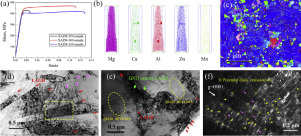当前位置:
X-MOL 学术
›
Acta Mater.
›
论文详情
Our official English website, www.x-mol.net, welcomes your
feedback! (Note: you will need to create a separate account there.)
Mechanistic investigation of a low-alloy Mg–Ca-based extrusion alloy with high strength–ductility synergy
Acta Materialia ( IF 8.3 ) Pub Date : 2020-03-01 , DOI: 10.1016/j.actamat.2020.01.017 Hucheng Pan , Rui Kang , Jingren Li , Hongbo Xie , Zhuoran Zeng , Qiuyan Huang , Changlin Yang , Yuping Ren , Gaowu Qin
Acta Materialia ( IF 8.3 ) Pub Date : 2020-03-01 , DOI: 10.1016/j.actamat.2020.01.017 Hucheng Pan , Rui Kang , Jingren Li , Hongbo Xie , Zhuoran Zeng , Qiuyan Huang , Changlin Yang , Yuping Ren , Gaowu Qin

|
Abstract High strength–ductility synergy is difficult to achieve in Mg alloys. Although high strength has been achieved through considerable alloying addition and low-temperature extrusion, these techniques result in low ductility (2%–5%). In this work, a novel low-alloy Mg–Ca-based alloy that overcomes this strength–ductility trade-off is designed. The alloy has an excellent tensile yield strength (∼425 MPa) and exhibits a reasonably high elongation capacity (∼11%). A microstructure examination reveals that a high density of submicron grains and nano-precipitates provides the alloy high strength, and the leaner alloy additions and higher extrusion temperatures initially improve ductility. As a result, the density of residual dislocations is reduced, and the formation of low-angle grain boundaries (LAGBs) is enhanced. With fewer residue dislocations, it becomes less probable for the newly activated mobile dislocations to be impeded and transformed into an immobile type during the subsequent tensile test. The LAGBs function as potential sites to emit new dislocations, thus enhancing the dislocation–multiplication capability. More importantly, they can induce evident sub-grain refinement hardening and guarantee that the alloy achieves high strength. The findings lead to a controllable Mg alloy design strategy that can simultaneously afford high strength and ductility.
中文翻译:

具有高强延性协同作用的低合金镁钙基挤压合金的力学研究
摘要 镁合金难以实现高强度-塑性协同作用。尽管通过大量的合金添加和低温挤压实现了高强度,但这些技术导致低延展性(2%–5%)。在这项工作中,设计了一种新型的低合金 Mg-Ca 基合金,可以克服这种强度-延展性的权衡。该合金具有优异的拉伸屈服强度(~425 MPa),并具有相当高的伸长率(~11%)。微观结构检查表明,高密度的亚微米晶粒和纳米沉淀物为合金提供了高强度,而更稀薄的合金添加量和更高的挤压温度最初会提高延展性。结果,残余位错的密度降低,并且低角度晶界(LAGB)的形成增强。随着残留位错的减少,新激活的移动位错在随后的拉伸试验中被阻止并转化为固定类型的可能性变得更小。LAGBs 作为潜在位点发出新的位错,从而增强了位错倍增能力。更重要的是,它们可以诱导明显的亚晶粒细化硬化,保证合金达到高强度。这些发现导致了一种可控的镁合金设计策略,可以同时提供高强度和延展性。它们可以引起明显的亚晶粒细化硬化,保证合金达到高强度。这些发现导致了一种可控的镁合金设计策略,可以同时提供高强度和延展性。它们可以引起明显的亚晶粒细化硬化,保证合金达到高强度。这些发现导致了一种可控的镁合金设计策略,可以同时提供高强度和延展性。
更新日期:2020-03-01
中文翻译:

具有高强延性协同作用的低合金镁钙基挤压合金的力学研究
摘要 镁合金难以实现高强度-塑性协同作用。尽管通过大量的合金添加和低温挤压实现了高强度,但这些技术导致低延展性(2%–5%)。在这项工作中,设计了一种新型的低合金 Mg-Ca 基合金,可以克服这种强度-延展性的权衡。该合金具有优异的拉伸屈服强度(~425 MPa),并具有相当高的伸长率(~11%)。微观结构检查表明,高密度的亚微米晶粒和纳米沉淀物为合金提供了高强度,而更稀薄的合金添加量和更高的挤压温度最初会提高延展性。结果,残余位错的密度降低,并且低角度晶界(LAGB)的形成增强。随着残留位错的减少,新激活的移动位错在随后的拉伸试验中被阻止并转化为固定类型的可能性变得更小。LAGBs 作为潜在位点发出新的位错,从而增强了位错倍增能力。更重要的是,它们可以诱导明显的亚晶粒细化硬化,保证合金达到高强度。这些发现导致了一种可控的镁合金设计策略,可以同时提供高强度和延展性。它们可以引起明显的亚晶粒细化硬化,保证合金达到高强度。这些发现导致了一种可控的镁合金设计策略,可以同时提供高强度和延展性。它们可以引起明显的亚晶粒细化硬化,保证合金达到高强度。这些发现导致了一种可控的镁合金设计策略,可以同时提供高强度和延展性。











































 京公网安备 11010802027423号
京公网安备 11010802027423号